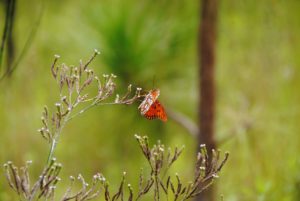
Johnny is continuing what his ancestor started more than 200 years ago.
By Chris Groskreutz, NRCS, Michelle Stone and Buford Sanders, Georgia Forestry Commission
Meet Johnny Bembry of Pulaski County, Georgia. The Bembry family has made a living on their farm for over 200 years, adapting and evolving how they manage the land as needed. Diverse ventures in row crops, cattle and timber has led to an array of benefits, including profitable lands, cleaner water downstream and top-notch wildlife habitat.
Family Roots
Johnny is continuing what his great, great, great, great grandfather started. More than two centuries ago, William Lancaster purchased the land following the Revolutionary War. It was the first land bought in the county, and it was the creek that cut through the property that got his attention.
William built a dam on the creek that was later used to hydropower a grist mill. It would be renovated and rebuilt over the centuries, hosting weddings and social functions along the way. Today, it’s used as an agricultural irrigation reservoir.
The upland surrounding the old mill pond has remained in timber production since the original purchase and some of the trees found nearby are hulking reminders of a time gone by.
“I don’t know how old that pine tree is and there isn’t an increment bore big enough to safely determine it,” Johnny said. “We’ll just have to wait to figure that out one day when it dies.”
Conservation Abound
Johnny turned to USDA for help in planning and implementing a variety of conservation practices on the land, using expertise and programs from both USDA’s Natural Resources Conservation Service and Farm Service Agency.
This assistance helped Johnny and his family manage his working lands so that they remain profitable while also providing many natural resource benefits. Their efforts to reestablish and improve forestlands were bolstered by the family’s participation in the Conservation Reserve Program and other USDA programs and initiatives.

The Bembry’s efforts have led to an array of benefits, including profitable lands, cleaner water downstream and top-notch wildlife habitat.
Through the Environmental Quality Incentive Program, Conservation Stewardship Program, and the Longleaf Pine Initiative, the Bembry family continues to improve existing timber stands, expand their longleaf acreage and establish native warm season grasses.
Well-managed forests, like Johnny’s, provide critical wildlife habitat for wildlife. From the northern bobwhite to the gopher tortoise, a variety of game and non-game species are thriving here.
For example, Johnny lets the grass grow up in fields to benefit ground-nesting birds like bobwhite.
“When the grass is growing the most, you think that’s when you need to mow, but if you can leave it alone while they are nesting, it’ll give them a chance,” he says.
Additionally, he has managed for wildlife openings, which provide food and habitat for a variety of species and he leaves old trees, or snags, behind to provide habitat for bats and other species. The property is home to countless bass, bream and catfish, the farm also enjoys a healthy wood duck population.
Love for the Land
Today, the family continues to grow timber, peanuts, corn, cotton, cattle and hay. Meandering through the land, you can witness how nine generations have been caretakers of this place and that they are planning for many more to come.
Johnny and his sister, Amy, believe in passing on the love for the land and all it offers us all, much like the generations before them did.
Johnny’s son, Tilden, is back home after working in Atlanta for several years with a goal to help manage the land. “The old expression is that absence makes the heart grow fonder,” he says. “The desire to enjoy the recreational benefits that the farm provides and to be nearer to family were both appealing. But I also felt a deeper sense of responsibility to continue to be a steward of the farm and the environment, as generations of my family have done in the past.”
More Information
USDA offers a variety of risk management, disaster assistance, loan, and conservation programs to help agricultural producers in the United States weather ups and downs in the market and recover from natural disasters as well as invest in improvements to their operations. Learn about additional programs.
For more information about USDA programs and services, contact your local USDA service center.
For an interactive version of this story, visit #FridaysOnTheFarm.





